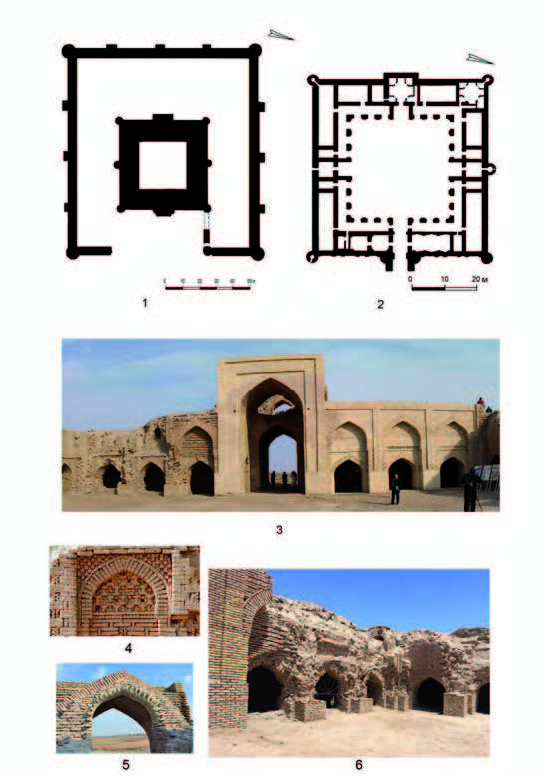CARAVANSERAIS: GENESIS, REGIONAL FEATURES, CLASSIFICATION
DOI:
https://doi.org/10.52967/akz2019.2.4.39.65Keywords:
archaeology, Central Asia, Armenia, Asia Minor, Iran, Great Silk Road, Middle Ages, trade, caravanserai, genesis, classificationAbstract
With the development of trade on the caravan routes, inns appear, the earliest known already in the 2nd millennium BC. After the Arab conquests in the East, a fairly standard and well-known inn type, called “caravanserai” or “han “. In Central Asia and Iran, at
the heart of the caravanserai plan is a vast courtyard surrounded by powerful walls, to which various premises are attached from within. In Armenia, an original type of closed caravanserai hall was developed. The most common type of caravanserai in Asia Minor is a synthesis of courtyard and hall buildings. Despite the fact that there are quite a few generalizing works in which caravanserais of various countries of the East are collected and analyzed, a classification of this very important category of buildings has not yet been
created. The proposed typology is based on the planimetry of buildings. The proposed classification uses the following characteristics: the presence or absence of an open courtyard, the number of courtyards, the shape of the plan, the number of entrances, the building of the courtyard, the location of the rooms, the presence of a colonnade. The proposed classification is quite universal and reflects most of the elements that make up the floor plan. In addition, it allows you to depict the layout of buildings in the form of a short code.
References
Bartold, V. V. 1927. Istoria kulturnoi zhizni Turkestana (The history of the cultural life of Turkestan). Leningrad: AN SSSR Publ. (in Russian).
Bartold, V. V. 1963. Turkestan v epohu mongolskogo nashestvia (Turkestan in the era of the Mongol invasion ). Moscow: «Nauka» Publ. (in Russian).
Buryakov, Ju. F. 1978. Po drevnim karavannym putjam Tashkentskogo oazisa (On the ancient caravan routes of the Tashkent oasis). Tashkent: „Fan“ Publ. (in Russian).
Vishnevskaya, O. A. 1958. In Arheologicheskie i etnograficheskie raboty Horezmskoi ekspeditsii 1949–1953. Trudy HAEE. T. II (Archaeological and ethnographic works of the Khorezm Expedition 1949–1953. Proceedings of HAEE. T. II). M.: AN SSSR Publ., 431-467 (in Russian).
Vseobschaja istorija arhitektury (General History of Architecture), 1. 1970. Leningrad-Moscow: Izd-vo literatury po stroitelstvu (in Russian).
Vseobschaja istorija arhitektury (General History of Architecture), 8. 1969. Leningrad–Moscow: Izd-vo literatury po stroitelstvu (in Russian).
Litvinskii, B. A., Zeimal, T. I. 2010. Buddiiskii monastyr Adzhina-tepa. Raskopki. Arhitektura. Iskusstvo (Buddhist monastery Ajina Tepa. Excavations. Architecture. Art). Saint Petersburg: «Nestor-istoria» Publ. (in Russian).
Mankovskaya, L. Ju. 1980. Tipologicheskie osnovy zodchestva Srednej Azii. IX – nachalo XX v. (Typological foundations of Central Asian architecture. IX-early XX century). Tashkent: «Fan» Publ. (in Russian).
Mankovskaya, L. Ju. 2014. Formoobrazovanie i tipologija zodchestva Srednej Azii. IX – nachalo XX veka (The formation and typology of the architecture of Central Asia. IX – early XX century). Tashkent: «Baktria Press» Publ. (in Russian).
Muhamejanov, A. R., Adylov, Sh. T., Mirzahmedov, D. K., Semenov, G. L. 1988. Gorodische Pajkend. K probleme izuchenija srednevekovogo goroda Srednei Azii (Pikend site To the problem of studying the medieval city of Central Asia). Tashkent: «Fan» Publ. (in Russian).
Nemtseva, N. B. 1977. In Rannesrednevekovaya kultura Srednei Azii i Kazahstana (Early medieval culture of Central Asia and Kazakhstan ). Dushanbe, 163-165 (in Russian).
Nemtseva, N. B. 1983. In Hudozhestvennaya kultura Srednei Azii IX–XIII vv. ( Artistic culture of Central Asia IX–XIII centuries.) Tashkent: Izd-vo liter. i iskusstva, 135-146 (in Russian).
Nemtseva, N. B. 2010. In Otzvuki Velikogo Horezma (Echoes of the Great Khorezm). Moscow, 267-311.
Pugachenkova, G. A. 1958a. Puti razvitija arhitektury Juzhnogo Turkmenistana pory rabovladenija i feodalizma (Ways of developing the architecture of Southern Turkmenistan pores of slavery and feudalism). Moscow: AN SSSR Publ. (in Russian).
Pugachenkova, G. A. 1958b. In Trudy JuTAKE (Proceedings of YTAKE), 8. Ashhabad (in Russian).
Pugachenkova, G. A. 1963. In Trudy JuTAKE (Proceedings of YTAKE), 12. Ashhabad (in Russian).
Smirnova, O. I. 1970. Ocherki po istorii Sogda (Essays on the history of Sogd). Moscow (in Russian).
Tolstov, S. P. 1948. Drevnii Horezm (Ancient Khorezm). M.: Moscow State University Publ. (in Russian).
Halpahchyan, O. H. 1959. In Arhitekturnoe nasledstvo (Architectural heritage), 11, 105-133 (in Russian).
Halpahchyan, O. H. 1971. Grazhdanskoe zodchestvo Armenii (zhilye i obschestvennye zdanija) (Armenian civil architecture (residential and public buildings)). Moscow: Stroiizdat (in Russian).
Hmelnitskii, S. 1992. Mezhdu arabami i tjurkami. Arhitektura Srednej Azii IX–X vv. (Between the Arabs and the Turks. Architecture of Central Asia IX–X centuries). Berlin–Riga: «Continent» (in Russian).
Hmelnitskii, S. 1996. Mezhdu Samanidami i mongolami. Arhitektura Srednej Azii XI – nachala XIII vv. (Between the Samanids and the Mongols. The architecture of Central Asia XI – early XIII centuries). Berlin–Riga: “Gamajun“ Part I (in Russian).
Barthold, V. 1933. Der iranische Buddhismus und sein Verhältnis zum Islam // Oriental studies in honour of C.E. Pavry. London, Godard A. L’Art de Iran. Paris, 836 p.
Godard A. L’Art de Iran. Paris: Arthaud, 1962. 836 c.
Herzfeld E. 1943. Damaskus. Studies in Architecture. Ars Islamica. Vol. 10. Ann Arbor, 13-70.
Hillenbrand R. 1994. Islamic Architecture. New-York, 645 p.
Kleiss W. 1996. Karawanenbauten in Iran. T. I // Materialen zur Iranischen Archäologie, B. 2. Deutsches Archäologisches Institut. Abteilung Teheran. Berlin, 322 p.
Stierlin H. 1998. Turkey from the Selçuks to the Ottomans. Köln: Taschen, 238 p.

Downloads
Published
How to Cite
Issue
Section
License
Copyright (c) 2019 E.D. Zilivinskaya

This work is licensed under a Creative Commons Attribution-NonCommercial 4.0 International License.






